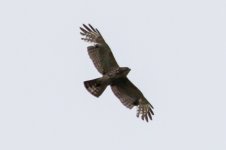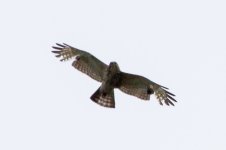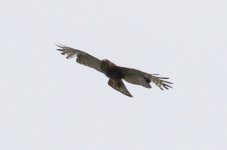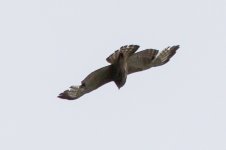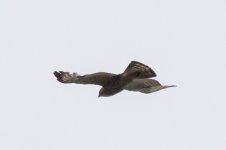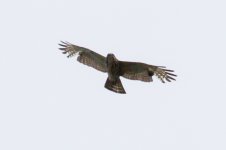-
Welcome to BirdForum, the internet's largest birding community with thousands of members from all over the world. The forums are dedicated to wild birds, birding, binoculars and equipment and all that goes with it.
Please register for an account to take part in the discussions in the forum, post your pictures in the gallery and more.
You are using an out of date browser. It may not display this or other websites correctly.
You should upgrade or use an alternative browser.
You should upgrade or use an alternative browser.
Hawk Southern Ontario (1 Viewer)
- Thread starter mordovarot
- Start date
More options
Who Replied?The Bird Nuts
Birding Duo
Immature Broad-winged Hawk.
Jeff Hopkins
Just another...observer

Another for red-shoulder
mordovarot
Well-known member
Thank you guys.
Seen the day before yesterday at Point Pelee, if it could help.
Seen the day before yesterday at Point Pelee, if it could help.
Last edited:
Thank you guys.
Seen the day before yesterday at Point Pelee, if it could help.
According to Wheeler in his "Raptor's of Eastern North America" on the migration of the Eastern Red-shouldered Hawk; peak movements of Juvenile RSHs appear along Lake Ontario in mid May. see p. 199.
Bob
mordovarot
Well-known member
Thanks Bob, it makes sense.
The Bird Nuts
Birding Duo
I'm not convinced. The short-ish tail, compact body, white throat with a stripe down the middle, and the sparse, coarse streaking on its breast and flanks all say Broad-winged to me. Yes, it has windows near the wingtips, but it is obviously molting and they seem to be pretty large translucent panels instead of crescents. |:S|
tom baxter
Well-known member
This is definitely an immature Broad-winged hawk, as can be most easily noted by the white throat and streaked sides of the breast, but can also be noted by the shorter tail and narrower hand that make it look more compact overall.
mordovarot
Well-known member
gerdwichers8
Well-known member
Broad-winged may have been a 'first impression' just as it was mine but this is a Red-shouldered Hawk.
Structure of the bird and patterning to both hand and tail says it all.
Structure of the bird and patterning to both hand and tail says it all.
mordovarot
Well-known member
First of all thanks to all for the discussion. My first impression in the field was a sparrow hawk 
Broad-winged may have been a 'first impression' just as it was mine but this is a Red-shouldered Hawk.
Structure of the bird and patterning to both hand and tail says it all.
What about the patterning and structure says RSHA?
The features noted above--short-tail, bulky compact body, white throat with single stripe, plus the short and thick malar all support BWHA. The molt is distorting structure in hand and appearance of windows (I don't see any crescent shape BTW).
Last edited:
tom baxter
Well-known member
im not sure why people think rsha. the structure is better for bwha as is the plumage. In these photos the plumage is more reliable but the 1st and 4th photo of the second set of images are strongly supportive of bwha structure in my opinion.
I would need to see a picture of a rsha with streaks on the sides of the neck that form the appearance of a strongly delineated white throat before I would even consider rsha personally. I don’t think they can look that way. Even if there is one out there, the plumage is still completely typical of immature bwha andthe structure still fits it. Structure may be more subjective here but I’m very confident in it.
I would need to see a picture of a rsha with streaks on the sides of the neck that form the appearance of a strongly delineated white throat before I would even consider rsha personally. I don’t think they can look that way. Even if there is one out there, the plumage is still completely typical of immature bwha andthe structure still fits it. Structure may be more subjective here but I’m very confident in it.
Last edited:
Every photograph of a soaring Broad-winged Hawk in Wheeler's "Raptors of North America" show only 4 primaries.
His photographs of soaring Red-shouldered Hawks show 5 and 6 primaries. Plate 221 of a juvenile "southern" RSH quotes: "Tawney crescent-shaped panel on outer 6 primaries." Plate 222 of a juvenile "Eastern" RSH quotes: "Tawny crescent-shaped window on base of outer 6 primaries."
In reference to Posts #9 and #15 comments about "white throat with single stripe:" Wheeler also notes in "Similar Species" to Broad-winged Hawk at page 213 of the Eastern edition (4) Red-shouldered Hawk, juveniles--PERCHED.--"Head can be identical in all races, including dark mid-throat stripe."
His photographs of soaring Red-shouldered Hawks show 5 and 6 primaries. Plate 221 of a juvenile "southern" RSH quotes: "Tawney crescent-shaped panel on outer 6 primaries." Plate 222 of a juvenile "Eastern" RSH quotes: "Tawny crescent-shaped window on base of outer 6 primaries."
In reference to Posts #9 and #15 comments about "white throat with single stripe:" Wheeler also notes in "Similar Species" to Broad-winged Hawk at page 213 of the Eastern edition (4) Red-shouldered Hawk, juveniles--PERCHED.--"Head can be identical in all races, including dark mid-throat stripe."
Last edited:
gerdwichers8
Well-known member
What about the patterning and structure says RSHA?
most easy will be the tailpattern. Whereas a juv. Broad-winged will have a broad subterminal band and the pale inner bands equal to that but both will be much broader than the inner dark bands; a juv. Red-shouldered will show bands of more equal width alltogether.
This situation is partially maintained if it comes to the wing. The distal barring reflects the more even but coarse character of a Red-shouldered Hawk. And yes, the crescent is there too.
regarding wing structure, I agree with Ceasar but for more structural comparisons I will have to continue considerations myself.
While reviewing Wheeler's paragraph at p. 209 of his Eastern Edition on the juvenile traits of the Broad-winged Hawk I found this information that I had previously partially underlined in red about the WINGS which I think is suitable for discussion. I can't remember why I underlined it.
--
"Undersides of the remiges are uniformly white with narrow dark barring on the secondaries and inner primaries. Underside of the primary tips is either solid gray or has narrow dark barring. (My red underlining begins here) When backlit, undersides of primaries often exhibit a translucent rectangular window, especially when wings are held in a glide position." (end of my underlining)
Compare that to of the juvenile (Eastern) Red-shouldered Hawk at page 197 of the above book.
WINGS (ventral)---"White remiges have a moderately wide dusky trailing edge and narrow dark barring on most of the rest of the inner remiges. The crescent-shaped panel shows as a pale tawny area in translucent light. The panel may have dark barring on it. The outermost primaries may be uniformly dark or superimposed with darker partial barring."
I don't know if this can help resolve the identification of this bird but here it is anyway.
Bob
--
"Undersides of the remiges are uniformly white with narrow dark barring on the secondaries and inner primaries. Underside of the primary tips is either solid gray or has narrow dark barring. (My red underlining begins here) When backlit, undersides of primaries often exhibit a translucent rectangular window, especially when wings are held in a glide position." (end of my underlining)
Compare that to of the juvenile (Eastern) Red-shouldered Hawk at page 197 of the above book.
WINGS (ventral)---"White remiges have a moderately wide dusky trailing edge and narrow dark barring on most of the rest of the inner remiges. The crescent-shaped panel shows as a pale tawny area in translucent light. The panel may have dark barring on it. The outermost primaries may be uniformly dark or superimposed with darker partial barring."
I don't know if this can help resolve the identification of this bird but here it is anyway.
Bob
After reviewing photos, I've moved into the undecided camp. Bird seems to have the proportions of a BWHA, but the some aspects of the plumage would be unusual.
They have more primaries than that--10 on each wing I believe. You are talking about "fingers." As I already suggested, I believe the stage of molt means that's not a useful mark in this instance. The bird needs to spread feathers it ordinarily would not because it has fewer (useful) remiges than it ordinarily would.
Your description is somewhat exaggerated. There is not a "much broader" subterminal band in juveniles; there is a slightly broader subterminal band in some juveniles. In any event, I do not believe that is mentioned as a field mark in Sibley. And I believe it is because there is much variation among BWHAs in this respect and the absence of the characteristic is not a reliable indicator. Some links below:
http://kevinkarlsonphotography.com/gallery/v/Raptors/Buteos/Broad-winged+Hawk_+immature.jpg.html
https://birdsna.org/Species-Account/bna/species/brwhaw/introduction
https://www.oaklandaudubon.org/eagles-hawks?lightbox=dataItem-j9erunyf
Every photograph of a soaring Broad-winged Hawk in Wheeler's "Raptors of North America" show only 4 primaries.
They have more primaries than that--10 on each wing I believe. You are talking about "fingers." As I already suggested, I believe the stage of molt means that's not a useful mark in this instance. The bird needs to spread feathers it ordinarily would not because it has fewer (useful) remiges than it ordinarily would.
most easy will be the tailpattern. Whereas a juv. Broad-winged will have a broad subterminal band and the pale inner bands equal to that but both will be much broader than the inner dark bands; a juv. Red-shouldered will show bands of more equal width alltogether.
Your description is somewhat exaggerated. There is not a "much broader" subterminal band in juveniles; there is a slightly broader subterminal band in some juveniles. In any event, I do not believe that is mentioned as a field mark in Sibley. And I believe it is because there is much variation among BWHAs in this respect and the absence of the characteristic is not a reliable indicator. Some links below:
http://kevinkarlsonphotography.com/gallery/v/Raptors/Buteos/Broad-winged+Hawk_+immature.jpg.html
https://birdsna.org/Species-Account/bna/species/brwhaw/introduction
https://www.oaklandaudubon.org/eagles-hawks?lightbox=dataItem-j9erunyf
Last edited:
Users who are viewing this thread
Total: 2 (members: 0, guests: 2)




